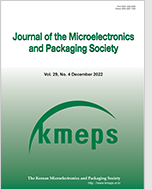
Search
- Past Issues
- e-Submission
-

KCI Accredited Journals KCI 등재지
KCI Impact Factor 0.54
Editorial Office
- +82-2-538-0962
- +82-2-538-0963
- kmeps@kmeps.or.kr
- http://kmeps.or.kr/

KCI Accredited Journals KCI 등재지
KCI Impact Factor 0.54
Journal of the Microelectronics and Packaging Society 2023;30(4):86-90. Published online: Feb, 20, 2024
DOI : doi.org/10.6117/kmeps.2023.30.4.086
The packaging of electronic devices performs a protective function to ensure that their durability and reliability are not affected by changes in the operating environment caused by external factors. Recent advances in materials have led to ongoing research into bonded packaging of heterogeneous materials such as polymers and inorganic materials in electronic devices. In this packaging process, it is important to have a binding that joins the materials and ensures the operating environment, which includes adhesion to the substrate, corrosion and oxidation resistance through moisture removal, and durability. In this study, the hygroscopicity of the coating layer by modifying the polymer surface based on PVA was evaluated by controlling and measuring the contact angle, and the adhesion was confirmed by applying water-based ink and testing according to ASTM_D3363. For the durability of the polymer surface, the IPL post-treatment process was used to improve the hardness and toughness against applied voltage, and the pencil hardness test and nanoindentation test were conducted. Through this, we analyzed and proposed solutions to ensure the reliability and durability of polymer devices in polymer microfabrication against environmental factors such as moisture, temperature fluctuations and adhesion, and surface abrasion.
Keywords Packaging, Hygroscopicity, Adhesion, IPL, Gradient Hardness